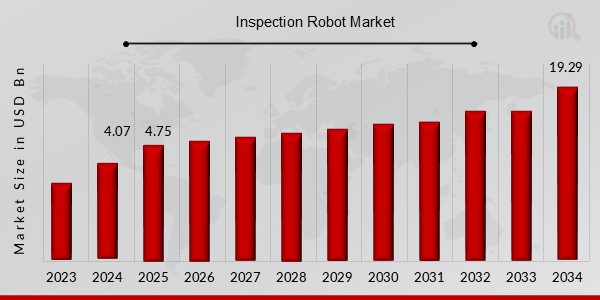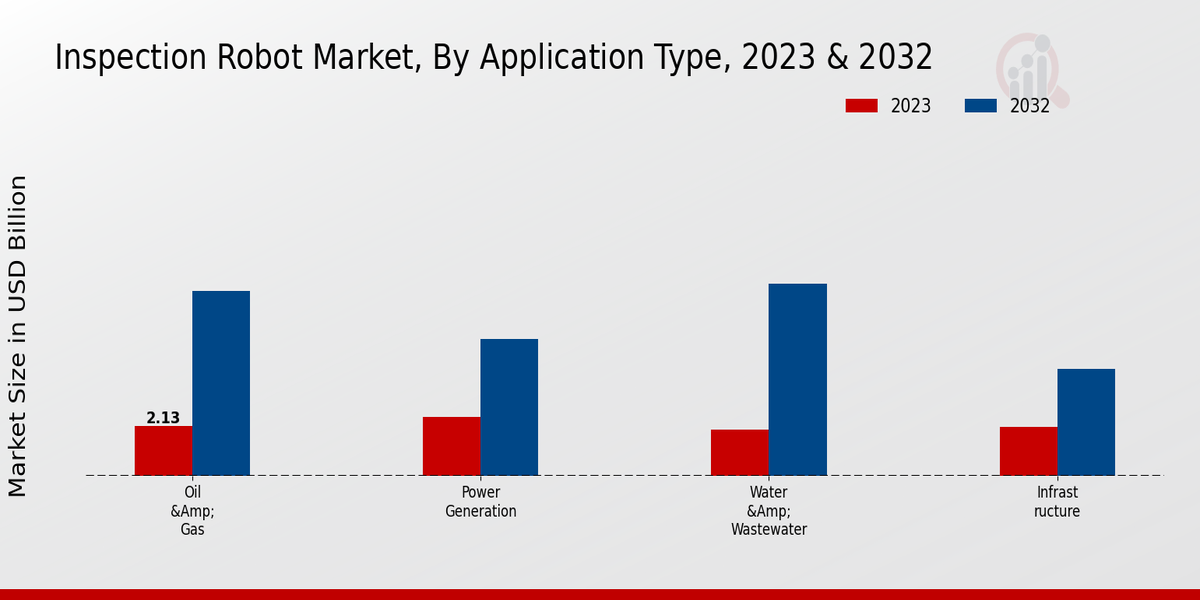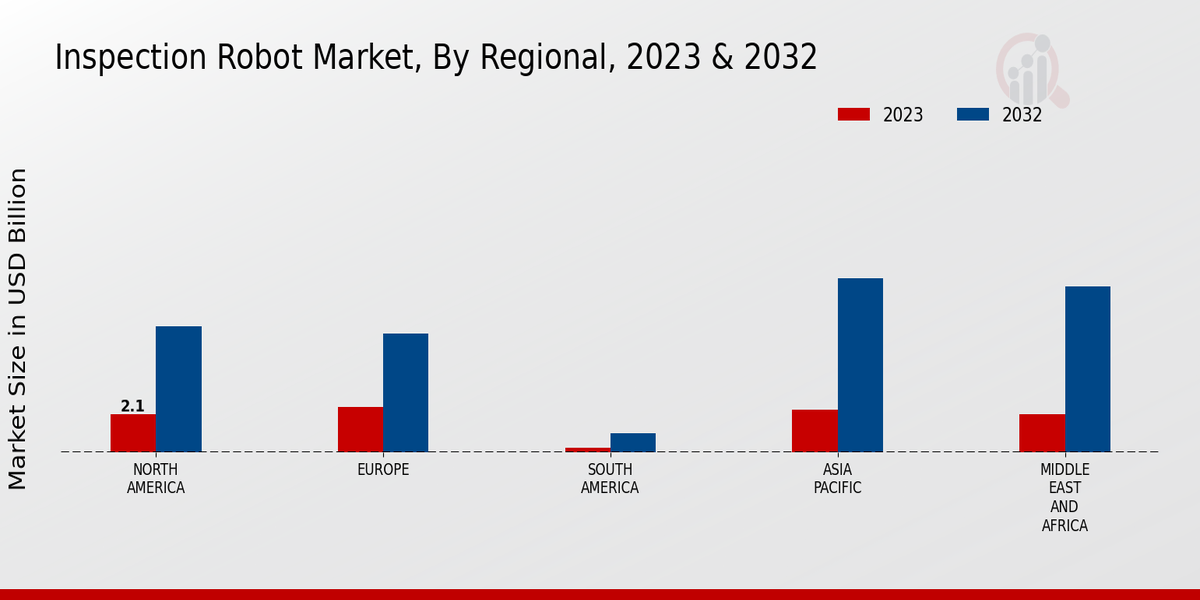Global Inspection Robot Market Overview
The Inspection Robot Market Size was estimated at 4.07 (USD Billion) in 2024. The Inspection Robot Market Industry is expected to grow from 4.75 (USD Billion) in 2025 to 19.29 (USD Billion) by 2034, with a CAGR (Growth Rate) of approximately 16.8% during the forecast period (2024–2034).

Source Primary Research, Secondary Research, MRFR Database and Analyst Review
Key Inspection Robot Market Trends Highlighted
The increasing demand for automation in hazardous and inaccessible areas, such as oil and gas pipelines, power plants, and construction sites, is driving the growth of the inspection robot market. Additionally, the need for improved safety and efficiency in inspection processes, as well as government regulations mandating regular inspections, are fueling market expansion.
The integration of advanced technologies, such as AI and IoT, into inspection robots presents significant growth opportunities. This allows for real-time data analysis, improved decision-making, and remote monitoring. Furthermore, the expansion into new industries, including healthcare and manufacturing, is creating potential for market growth.
Recent trends in the inspection robot market include the increasing adoption of autonomous and semi-autonomous robots that can perform inspections without human intervention. Additionally, the use of drones for aerial inspections is gaining traction, providing cost-effective and efficient solutions for large-scale inspections. The integration of 5G connectivity is also enhancing the performance and capabilities of inspection robots.
Inspection Robot Market Drivers
Rising Demand for Industrial Automation
One of the most important growth drivers of the Inspection Robot Market Industry is the increasing adoption of automation technologies in various industries. Manufacturers are increasingly looking for ways to enhance efficiency, decrease costs, and improve the quality of goods produced. As a result, they employ inspection robots that can carry out various operations automatically to facilitate the performance of dangerous or repetitive inspection tasks.
Since these technologies offer increased precision and speed, as well as allow performing operations in dangerous and otherwise inaccessible environments, they are considered advantageous in the manufacturing, automotive, and aerospace industries. In addition, the increased need for quality control and the necessity to comply with regulations further foster the demand for robots as they increase control of inspection outcomes and reduce the risk of errors in the final products.
Advancements in AI and Machine Learning
The integration of artificial intelligence (AI) and machine learning (ML) algorithms is revolutionizing the capabilities of inspection robots. AI-powered inspection robots can analyze vast amounts of data, identify patterns, and make intelligent decisions, enhancing their accuracy and efficiency. ML algorithms enable robots to learn from experience, continuously improving their performance over time. These advancements allow inspection robots to handle complex inspection tasks, such as defect detection, surface inspection, and object recognition, with greater precision and reliability. As AI and ML technologies continue to evolve, the Inspection Robot Market Industry is expected to witness further innovation and growth.
Growing Need for Remote Inspection and Monitoring
The demand for remote inspection and monitoring solutions is another factor that influences the growth of the Inspection Robot Market Industry. Remote inspection robots are used to examine assets and infrastructure in hazardous, remote, or difficult-to-reach areas without the need for human presence. In the oil and gas, mining, and utility sectors, regular inspection is essential for safety and maintenance, but the cost and infrequency of human inspection can make it challenging.Therefore, inspection robots are designed to move in difficult-to-reach places, collect data, and wirelessly communicate it back to engineers and technicians who can do the rest. Overall, the use of remote inspection technology is projected to rise, with more and more businesses seeking a suitable asset and maintenance solution that is both cost-effective and effective.
Inspection Robot Market Segment Insights
Inspection Robot Market Application Type Insights
The application type segment of the inspection robot market is divided into Oil Gas, Power Generation, Water Wastewater, and Infrastructure. Among them, the Oil Gas segment is expected to dominate the market with a significant revenue share in 2023. This leading position is the result of an increased demand for inspection robots in the oil and gas industries for pipeline inspection, tank inspection, and other applications. The Power Generation segment is also anticipated to develop significantly due to the higher necessity of inspection robots in power plants for boiler inspection, turbine inspection, and other applications.The growth of the Water Wastewater segment will be more stable and associated with an increasing demand for inspection robots in water and wastewater treatment plants for pipe inspection, tank inspection, and other applications. The growth of the Infrastructure segment will be rather moderate due to an increased usage of inspection robots in bridges, tunnels, and other infrastructure assets for inspection and maintenance purposes. Thus, the rapid growth of the inspection robot market will be the result of the increased demand for inspection robots in a variety of industries for the purpose of asset inspection and maintenance.

Source Primary Research, Secondary Research, MRFR Database and Analyst Review
Inspection Robot Market Deployment Mode Insights
The Deployment Mode is one of the major segmentations of the Inspection Robot Market, and each of these different vehicle types has advantages and applications. In the market, Remotely Operated Vehicles and Autonomous Underwater Vehicles dominate the market and account for a larger share of the Inspection Robot Market revenue. ROVs are tethered vehicles, controlled and powered by a surface control unit and acting according to real-time observations, so they may be preferred for inspecting in a hazardous environment. On the other hand, AUVs are untethered vehicles, dependent on their onboard sensors for observation and processing, following a predetermined path in relation to the regions being inspected – preferable when the desired inspection area is long or far.The other two vehicle modes are Tethered Vehicles and Untethered Vehicles; these are less popular than the previous two but also have certain specializations. Tethered Vehicles are always powered through a tether and do not require onboard power sources but provide continuous data and power transmission service so they can be maintained or store the data observed. Untethered Vehicles run independently and can be quickly moved from one inspection point to another. The most reliable segmentation of the vehicles depends on the conditions where they are being used and the costs of the deployment in use. These considerations provide valuable information for the people in the industry who wish to optimize the inspection process.
Inspection Robot Market Propulsion System Insights
The Inspection Robot Market is segmented by Propulsion System into Electric, Hydraulic, Pneumatic, and Chemical. Among these, the Electric segment is expected to hold the largest market share over the forecast period. The growth of this segment can be attributed to the increasing demand for electric inspection robots in various industries due to their advantages, such as low maintenance costs, high efficiency, and environmental friendliness.
The Hydraulic segment is also expected to witness significant growth over the forecast period due to the increasing demand for hydraulic inspection robots in harsh environments. The Pneumatic segment is expected to hold a steady market share over the forecast period due to its wide range of applications in various industries. The Chemical segment is expected to witness moderate growth over the forecast period due to its limited applications in specific industries.
Inspection Robot Market Payload Capacity Insights
The payload capacity segment is a crucial aspect of the Inspection Robot Market. It directly influences the robot's functionality, application areas, and market growth. The segment is categorized into three sub-segments Low (Under 10 kg), Medium (10-50 kg), and High (Over 50 kg). The Low payload capacity segment accounted for a significant share of the Inspection Robot Market revenue in 2023. These robots are compact and lightweight, making them suitable for confined spaces and delicate operations. They are widely used in industries such as oil and gas, power generation, and manufacturing.The Medium payload capacity segment is projected to witness substantial growth over the forecast period. These robots offer a balance between size and payload capacity, enabling them to handle a wider range of inspection tasks. They are increasingly adopted in the construction, infrastructure, and transportation sectors.
The High payload capacity segment is expected to gain traction in the coming years. These robots are equipped with powerful motors and robust structures, allowing them to carry heavy payloads. They are primarily used in heavy industries such as mining, shipbuilding, and offshore operations. The growth of the Inspection Robot Market is driven by factors such as the increasing demand for efficient and safe inspection methods, advancements in sensor and imaging technologies, and the expansion of the industrial automation sector. The market is expected to continue its upward trajectory, with significant opportunities emerging in various end-use industries.
Inspection Robot Market Regional Insights
The Inspection Robot Market is segmented by region into North America, Europe, APAC, South America, and MEA. North America is expected to hold the largest market share in 2023 and is projected to continue to lead the market throughout the forecast period. The growth of the North American market can be attributed to the increasing adoption of inspection robots in various industries, such as oil and gas, power generation, and manufacturing.
Europe is expected to be the second largest market for inspection robots, followed by APAC. The growth of the European market is being driven by the increasing demand for inspection robots in the automotive and aerospace industries.
The APAC market is expected to grow rapidly over the forecast period due to the increasing adoption of inspection robots in the manufacturing and infrastructure industries. South America and MEA are expected to be the smallest markets for inspection robots but are expected to grow steadily over the forecast period.

Source Primary Research, Secondary Research, MRFR Database and Analyst Review
Inspection Robot Market Key Players And Competitive Insights
The Inspection Robot Market's major players are also constant innovators. Often, they are trying to gain a competitive edge since the ongoing development and improvement of inspection robots is one of the key industry features. In order to enhance their competitiveness, the leading Inspection Robot Market players invest vast resources in research and development, designing more efficient, reliable, functional, and affordable inspection robots. Amid the outbreaks of competition that characterize the industry, key Inspection Robot Market players are focused on diversifying their product range, developing and peering new technologies, and improving their distribution network. Moreover, another common strategy employed within the industry is heavy mergers and acquisitions investment in order to increase the market presence of companies and expand their product and technology mix.
As an Inspection Robot Market major player is a company that has been atop of the industry for dozens of years. It includes a wide selection of inspection robots within its range, including robots designed for industrial cleaning or maintenance, other inspection robots valued by commercial companies, or inspection robots intended for military purposes. The range of iRobot inspection robots is widely recognized for its reliability, functionality, and durability. The inspection robots are distributed by authorized resellers in the focus markets of the company around the globe. Apart from that, iRobot company is making all the effort to remain a real innovator in the market in question, investing heavily in research and development.
Another Inspection Robot Market major player in question is Boston Dynamics. First of all, it should be said that its robots are primarily known as the most agile. Boston Dynamics’s robotic equipment is known for its exceptional flexibility while being utilized for both very simple and incredibly complex tasks, not to mention challenging environment performances. The company has received sufficient investments from Venture Capitalists and collaborated with leading industrial enterprises, as a result launching and popularizing its robotic equipment on the market. Finally, the Inspection Robot Market's major player, Boston Dynamics, is expected to continue pushing the existing industry’s boundaries, making astonishing progress in robotics.
Key Companies in the Inspection Robot Market Include
- ECA Group
- Subsea 7
- Flybotix
- Rovco
- Cyberhawk Innovations
- Saipem
- Boston Dynamics
- iRobot
- Inuktun Services
- ROVOP
- Endress+Hauser
- Flyability
- TechnipFMC
- Hydromea
- Oceaneering International
Inspection Robot Market Industry Developments
Rising demand for remote and real-time monitoring, increasing adoption of advanced technologies like AI and machine learning, and growing concerns regarding safety and efficiency in various industries are driving the market growth.
The Asia Pacific region is expected to hold a significant market share due to rapid industrialization and increasing investments in infrastructure development. Key players in the market include iRobot, Boston Dynamics, and ABB. Recent developments include the launch of new inspection robots with enhanced capabilities, such as the PipeGuard robot for inspecting pipelines and the Flyability Elios 3 drone for confined space inspections. The market is expected to witness continued growth in the coming years due to technological advancements and increasing demand for automation in various industries.
Inspection Robot Market Segmentation Insights
-
Inspection Robot Market Application Type Outlook
- Oil Gas
- Power Generation
- Water Wastewater
- Infrastructure
-
Inspection Robot Market Deployment Mode Outlook
- Remotely Operated Vehicles (ROVs)
- Autonomous Underwater Vehicles (AUVs)
- Tethered Vehicles
- Untethered Vehicles
-
Inspection Robot Market Propulsion System Outlook
- Electric
- Hydraulic
- Pneumatic
- Chemical
-
Inspection Robot Market Payload Capacity Outlook
- Low (Under 10 kg)
- Medium (10-50 kg)
- High (Over 50 kg)
-
Inspection Robot Market Regional Outlook
-
North America
-
Europe
-
South America
-
Asia Pacific
-
Middle East and Africa
| Report Attribute/Metric |
Details |
| Market Size 2024 |
4.07 (USD Billion) |
| Market Size 2025 |
4.75 (USD Billion) |
| Market Size 2034 |
19.29 (USD Billion) |
| Compound Annual Growth Rate (CAGR) |
16.84% (2025 - 2034) |
| Report Coverage |
Revenue Forecast, Competitive Landscape, Growth Factors, and Trends |
| Base Year |
2024 |
| Market Forecast Period |
2025 - 2034 |
| Historical Data |
2020 - 2024 |
| Market Forecast Units |
USD Billion |
| Key Companies Profiled |
ECA Group, Subsea 7, Flybotix, Rovco, Cyberhawk Innovations, Saipem, Boston Dynamics, iRobot, Inuktun Services, ROVOP, Endress+Hauser, Flyability, TechnipFMC, Hydromea, Oceaneering International |
| Segments Covered |
Application Type, Deployment Mode, Propulsion System, Payload Capacity, Regional |
| Key Market Opportunities |
1 Rise in demand from oil and gas and power generation industries2 Growing adoption in nuclear power plants for inspection and maintenance3 Increasing demand for remote visual inspection RVI in hazardous environments4 Integration of advanced technologies like AI and IoT5 Government initiatives and regulations for safety and compliance |
| Key Market Dynamics |
Rising demand for automation, proliferation of AI and machine learning, growing need for efficient inspection processes, increasing investments in infrastructure, stringent government regulations |
| Countries Covered |
North America, Europe, APAC, South America, MEA |
Frequently Asked Questions (FAQ) :
The Inspection Robot Market is expected to reach USD 19.29 billion by 2034, exhibiting a CAGR of 16.84% from 2025 to 2034.
North America and Europe are anticipated to dominate the market, while Asia-Pacific is projected to witness the highest growth rate during the forecast period.
Oil and gas, power generation, manufacturing, and aerospace are the major industries fueling the demand for Inspection Robots.
Inspection Robots are primarily employed for pipeline inspection, tank inspection, and structural inspection.
Some of the prominent players in the market include iRobot Corporation, Boston Dynamics, and Endress+Hauser.
Rising demand for remote inspections, increasing adoption of automation, and growing awareness of safety regulations are driving the market growth.
High cost of deployment and limited availability of skilled professionals pose challenges to the market's growth.
Advancements in AI, computer vision, and sensor technologies are anticipated to enhance the capabilities and efficiency of Inspection Robots.
The market is predicted to witness increased adoption in various industries, with a focus on remote and autonomous inspection capabilities.
Growing emphasis on sustainability is driving the development of eco-friendly Inspection Robots with reduced environmental impact.
















